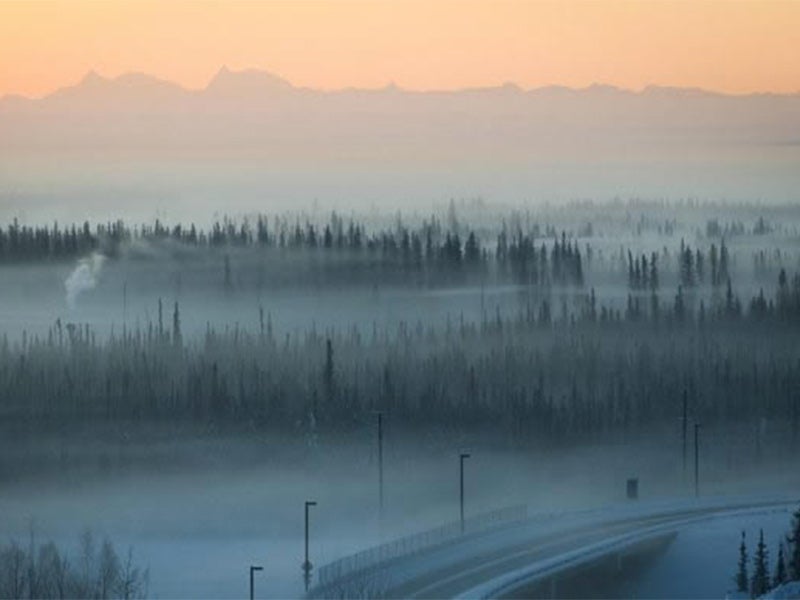Earthjustice stands with western Alaska tribes and families after severe storms devastated entire communities, displacing more than 1,000 residents just before winter. Learn more and how you can help.
Fairbanks Residents Notify EPA of Intent to Sue for Further Delay in Addressing Dirty Air
Community groups frustrated with the government’s continuing failure to address dirty air, some of the worst in the nation
Contact
The Fairbanks North Star Borough has some of the worst and most dangerous air quality in the nation. Today, Alaska community groups joined together—for the second time in as many years—to demand that responsible officials stop dragging their feet and finally address the problems that Borough residents and their families face when simply breathing in Fairbanks.
Of all the areas that fail to meet EPA air quality standards for PM-2.5, Fairbanks is the most polluted, with levels almost double the next most polluted area, at nearly four times the recommended standard.
Citizens for Clean Air, Alaska Community Action on Toxics, and the Sierra Club sent a letter calling on the U.S. Environmental Protection Agency (EPA) to meet its obligation under the law to approve or disapprove a plan submitted last year by the State of Alaska to address air pollution in Fairbanks. The letter, submitted by environmental law firm Earthjustice’s Alaska office, notified EPA of the community groups’ intent to sue if EPA does not act in 60 days.
The groups were already forced to sue EPA once, in April 2014, to move the state planning process for cleaning Fairbank’s air forward. This helped prompt the State of Alaska to submit an overdue plan to address air pollution to EPA in the end of January 2015. But EPA has now missed the next deadline required by law—to approve or disapprove the State’s plan. That deadline passed on February 18 of this year. The groups are now seeking to compel the agency to perform its duty under the Clean Air Act to make a decision on the plan, an important next step in addressing air pollution in the Fairbanks North Star Borough.
The type of fine‐particulate matter pollution prevalent in Fairbanks—2.5 micrometers or less in diameter—has been found to cause a wide range of serious health problems, including asthma attacks, chronic respiratory disease, reduction in lung function, hospitalizations and emergency room visits for cardiopulmonary diseases, cancer, and even premature death.
Of all the areas that fail to meet EPA air quality standards for this pollutant (referred to as PM‐2.5 by the EPA), Fairbanks is the most polluted, with levels almost double the next most polluted area, at nearly four times the recommended standard. Sources of PM‐2.5 in Fairbanks include outdoor burning; wood‐ and coal‐burning heating devices; automobiles and other vehicles; and industrial facilities like coal‐fired power plants. The air pollution problems have worsened since 2009, when state and municipal officials were first advised that soot and smoke levels in Fairbanks were unhealthy and dangerous.
More than a thousand health studies have linked this pollution to health issues. One study, conducted by the Alaska Department of Health and Social Services, found that poor air quality led to increased admissions for cerebrovascular disease and respiratory tract infections at Fairbanks Memorial Hospital. PM‐2.5 air pollution is of particular danger to children, reducing lung development, causing asthma, and impairing the immune system. The elderly and those with chronic disease also face heightened risk.
Read the 60-day notice of intent.
The following are statements from the groups:
Patrice Lee, Citizens for Clean Air: “When people think about Alaska, they think about pristine conditions, crisp, clean air. But step off the plane in Fairbanks, or drive into town, and it isn’t long before you know something isn’t right with the air. The air is hazy and smells bad. It isn’t exactly the twilight zone, it’s the ‘non‐attainment zone,’ an area now known to have the nation’s worst winter‐time air pollution. Most everyone knows someone who has asthma, heart‐rhythm problems, strokes, cancer, or chronic diseases. Bad air affects us; often we only realize once we’re really sick or it’s too late. Fairbanks has needed to clean‐up our air for over eight years. The EPA must do its job: enforce the Clean Air Act. One hundred thousand children, women, and men (and too many pets to count) in the Fairbanks North Star Borough Non‐Attainment Area are counting on it.”
Dr. Jeanne Olson, North Pole veterinarian: “Heavy smoke chronically inundates a group of area neighborhoods so consistently that it has been nicknamed ‘the Rectangle of Death.’ We are not asking for special treatment. We are merely insisting that our government follows the law established to protect our citizens from poisons in the air we need to breathe.”
Sharon Baring, Fairbanks school nurse and former public health nurse: “Missed school days and work days from prolonged and repeated colds and bronchitis, asthma flares, irregular heartbeats and fatigue—the quality of what we breathe is contributing to these. We all pay, if not in illness directly, then for the increased medical expenses and lost productivity that come from it.”
Pamela Miller, Executive Director, Alaska Community Action on Toxics: “This is a matter of extreme urgency for the health of people in Fairbanks, and especially for children and elderly people who are particularly vulnerable to the effects of this dangerous air pollution. We cannot tolerate further delays in implementing a plan that is necessary to protect public health. It is not an abstract issue for people in Fairbanks who are suffering the health consequences of inaction.”

Additional Resources
About Earthjustice
Earthjustice is the premier nonprofit environmental law organization. We wield the power of law and the strength of partnership to protect people's health, to preserve magnificent places and wildlife, to advance clean energy, and to combat climate change. We are here because the earth needs a good lawyer.